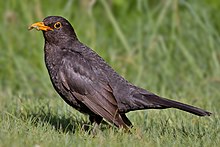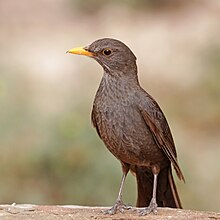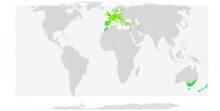
Back Amsel ALS የአውርስያ ዋሪ Amharic Turdus merula AN شحرور Arabic شحرور (نوع من الطيور) ARZ Turdus merula AST Qara qaratoyuq Azerbaijani Ҡара барҡылдаҡ Bashkir Дрозд чорны Byelorussian Дрозд чорны BE-X-OLD
| Common blackbird | |
|---|---|

| |
| Male T. m. merula | |

| |
| Female T. m. mauritanicus | |
| Scientific classification | |
| Domain: | Eukaryota |
| Kingdom: | Animalia |
| Phylum: | Chordata |
| Class: | Aves |
| Order: | Passeriformes |
| Family: | Turdidae |
| Genus: | Turdus |
| Species: | T. merula
|
| Binomial name | |
| Turdus merula | |

| |
| Global range based on reports to eBird Summer range Year-round range Winter range
| |
The common blackbird (Turdus merula) is a species of true thrush. It is also called the Eurasian blackbird (especially in North America, to distinguish it from the unrelated New World blackbirds),[2] or simply the blackbird where this does not lead to confusion with a similar-looking local species. It breeds in Europe, western Asia, and North Africa, and has been introduced to Australia and New Zealand.[3] It has a number of subspecies across its large range; a few former Asian subspecies are now widely treated as separate species. Depending on latitude, the common blackbird may be resident, partially migratory, or fully migratory.
The adult male of the common blackbird (Turdus merula merula, the nominate subspecies), which is found throughout most of Europe, is all black except for a yellow eye-ring and bill and has a rich, melodious song; the adult female and juvenile have mainly dark brown plumage. This species breeds in woods and gardens, building a neat, cup-shaped nest, bound together with mud. It is omnivorous, eating a wide range of insects, earthworms, berries, and fruits.
Both sexes are territorial on the breeding grounds, with distinctive threat displays, but are more gregarious during migration and in wintering areas. Pairs stay in their territory throughout the year where the climate is sufficiently temperate. This common and conspicuous species has given rise to a number of literary and cultural references, frequently related to its song.
- ^ BirdLife International (2016). "Turdus merula". IUCN Red List of Threatened Species. 2016. doi:10.2305/IUCN.UK.2016-3.RLTS.T103888106A87871094.en. Retrieved 25 July 2019.
- ^ Alderfer, Jonathan, ed. (2006). Complete Birds of North America. Washington, D.C.: National Geographic Society. p. 489. ISBN 0-7922-4175-4.
- ^ Long, John L. (1981). Introduced Birds of the World. Agricultural Protection Board of Western Australia. pp. 21–493. ISBN 9780876633182.
© MMXXIII Rich X Search. We shall prevail. All rights reserved. Rich X Search
